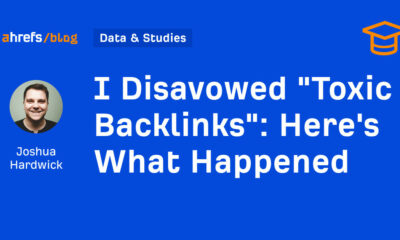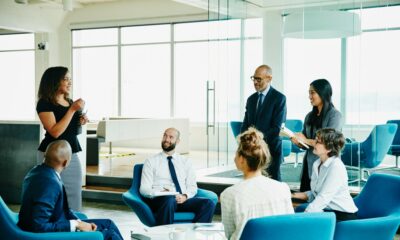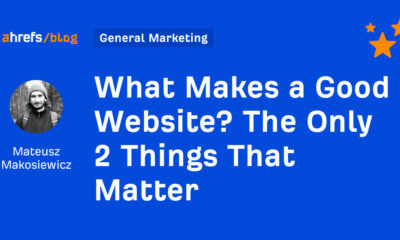PPC
What is Social Selling? (+How to Sell on Social Media)

If you sell things to people who spend time on social media, you need to learn about social selling.
Social selling lets you use social media to find perfect prospects, build a genuine connection with them, and become the automatic choice when it’s time to buy.
It’s not rocket science. But you can’t go in guns blazing with the hard sales tactics. There’s more nuance required.
In this extensive guide, you’ll get a complete plan to launch your own social selling strategy. What to post, when to connect, and how to get more conversions with less pitching.
Table of contents
What is social selling?
Social selling is a lead generation strategy where you find, qualify, and connect with new prospects on social networks. The strategy includes using social listening to know what topics are important to prospects and then joining or generating conversations to build relationships with them.
Let’s say you work for a commercial contractor. Someone on X (formerly Twitter) talks about expanding their business in your area and has a question about building codes. You give an answer with some helpful links. You’re at the top of the list when they ask for a bid to upgrade their new building.
Notice that social selling focuses on generating new leads rather than quick conversions. You want to build trust through genuine connection, not complete an impersonal transaction.
The best part of social selling is that it’s like a free, always-on networking event you don’t have to fly to. You get to generate and nurture 1:1 relationships at a scale you never could with in-person networking or cold calls.
💡 Want more oomph in your outreach? Download this huge list of emotionally charged marketing words and phrases.
Social selling vs. traditional selling
Social selling differs from traditional sales strategies by where it happens, who you target, and how you connect.

Social selling happens on social media platforms. Traditional selling often takes place in person or via cold calls.
With social selling, you directly target product users or decision-makers. Traditional sales strategies usually start with engaging a gatekeeper before you speak with the person writing the checks.
Social selling uses warm introductions and personalized conversations to engage with targeted prospects. Traditional sales tactics rely on generic scripts and shotgun outreach.
Social selling vs. social media marketing
Social media marketing is usually a one-to-many broadcast. In contrast, social selling is more about building relationships with one-to-one conversations.
Social media marketing can also be conversion-focused and even include social shopping, where people can buy right from the social media platform. With social selling, you’re meeting and interacting with prospects, but the conversion happens outside the social network.
While they have differences, social media marketing and social selling do support each other. You may write some generally helpful social media posts as part of your social media marketing strategy, but when a prospect comments, they move into your social selling funnel.
Who is social selling for?
Social selling is for any company that sells products to people who spend time on social media. That is to say, it’s for just about every company since over 62% of the global population (and over 90% of the US population) is on social media.
Any size business can use social selling. A Fortune 500 software company might interact with chief technology officers who make million-dollar purchasing decisions. A local physical therapist can provide health tips to weekend warrior athletes in their network.
What are the benefits of social selling?
Social selling isn’t hard (we think it’s fun), but it takes some time. Are you on the fence about trying it? Let’s see if these social selling benefits convince you.
You connect with people where they’re comfortable
The average person spends about 2.5 hours each day scrolling social media platforms. Many are there to catch up with friends and family. But a large percentage of people head to social networks to learn about products and get content from brands.
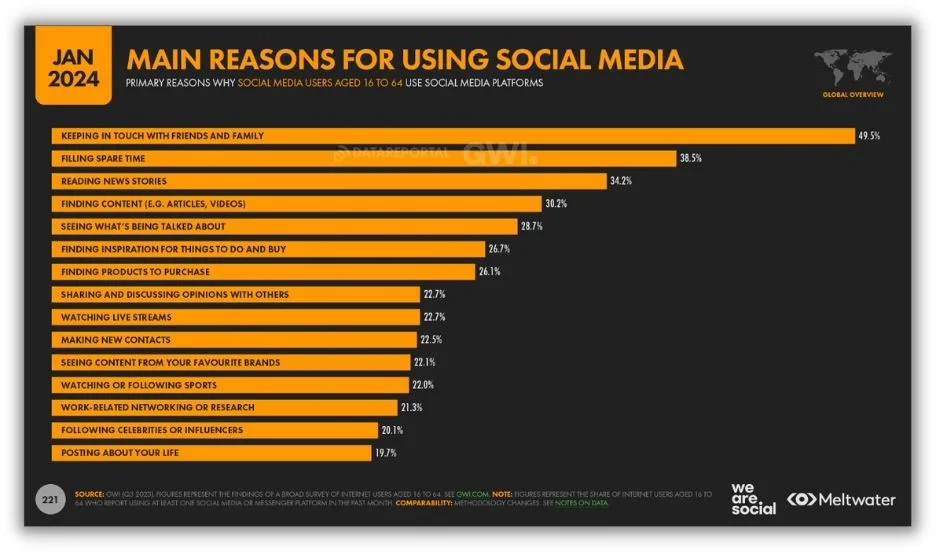

That audience of information seekers presents a perfect opportunity to jump in and be the helpful authority when they need you most.
Builds trust through conversation
An older study from HubSpot showed that a dismal 3% of consumers consider salespeople trustworthy. Ouch!
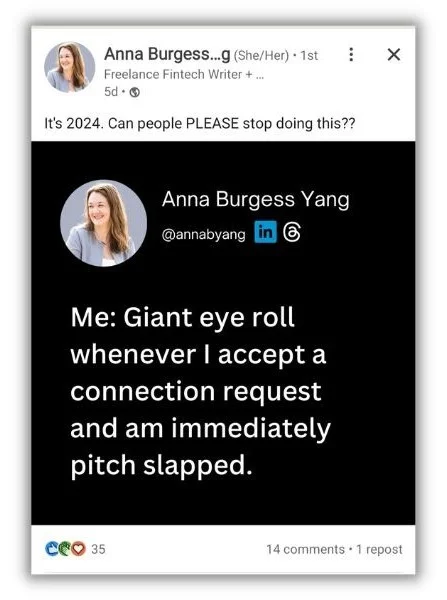

You’re unlikely to overcome the trust gap in the first few seconds of a cold call. But on social media, it’s possible to create relationships that generate trust over time.
Think about it this way. Say you need to hire more people. Would you be more likely to use a recruiting company that’s answered several hiring questions for you on LinkedIn or the company that cold-called you?
Lets you time outreach perfectly
In general, success on social media means posting at the right time. And that’s why social selling is so great. You use social listening to tell you when someone’s talking about your brand, your competitors, or some aspect of your business. Then, you can connect with them at the exact right time.


Every major social media platform has a search bar. You can use it to search for hashtags, company names, or job titles that lead you to excellent prospects.
Plus, social media bios often hold lots of information about the people they represent. With a quick glance, you might learn where someone works, their job title, and what types of things they’re interested in.
You’d have to buy one heck of a cold-calling list to get all of that!
It’s a proven technique
LinkedIn data shows that sales teams who use social selling are more successful.
According to the research, social selling leaders:
- Create more opportunities
- Are more likely to reach quota
- Outsell peers who don’t use social media


What’s more, your competitors are already taking advantage of social selling. Compared to 2015, sales reps spend 12% more time connecting with prospects and customers virtually.
EveryoneSocial, a brand advocacy software provider, says that social sellers close 48% larger deals than their nonsocial seller counterparts.
Delivers a fantastic ROI
All you need to get started with social selling is a free social media account, a little time, and a strategy. There’s no significant initial investment, ads to buy, or travel to pay for.
As you start to generate quality leads from social media, you can invest in tools that make you more efficient, which we’ll cover in a bit.
What are the four pillars of social selling?
There are four concepts that, when taken together, form the foundation of a social selling strategy.


- Establish your brand on social media: Before connecting with prospects, create an engaging profile and publish relevant content that cements your brand as the expert in your space.
- Fill out your network: Identify your current customers, future potential customers, thought leaders, and influencers that you’d like to connect with.
- Engage them with insights: Become the go-to source for information by sharing thought-provoking directly with your prospects right when they need it.
- Build relationships: Strengthen your connections by establishing trust with the people who make decisions and influence others.
Which social selling platforms are best?
The best social selling platform for you depends a lot on the things you sell and where your audience hangs out.
That said, LinkedIn and Twitter are more geared towards social selling. People go to those networks more often for professional conversations. Plus, those platforms have some great tools to make creating a sales network easier.
LinkedIn is the best platform for B2B social selling. Not only does the platform have more than 1 billion users, but most of them are also there to talk shop. That means your conversations about professional topics will fit right in.
LinkedIn makes it really easy to grow your professional network. You can use the search bar at the top of the page to look for specific job titles or people working for a company. Then, you can refine the list to only show people connected with your current network. Hello, warm introductions!
There’s also a really powerful tool called LinkedIn Sales Navigator. Use it to prioritize your prospects, find advocates who’ll help you connect, and even surface accounts showing high buying intent.
And the pièce de rèsistance is LinkedIn’s social selling index (SSI).


The SSI is a metric from LinkedIn that measures your success against the four pillars of social selling. Just log into your account and head to your Social Selling Index dashboard. You’ll get an overall score and see how you fare against others in your industry.
X (formerly Twitter)
X is built for public discussions, which makes it a perfect place to jump into conversations and establish your brand’s expertise.
Finding those conversations is easy since many users add hashtags to their tweets. Search for hashtags using the bar at the top or click a hashtag from someone you already follow and see who else is using it.
Say one of your customers uses the hashtag #HRIssues on their Tweets. Click it, and you’ll likely find a host of other prospects who need your human resources software.
But what’s really cool about X is the List feature. With Lists, you can quickly find whole groups of people in your field.


Follow existing lists to grow your network. Or create your own private lists to keep tabs on competitors or customers.
Facebook, TikTok, and Instagram
Facebook, TikTok, and Instagram are popular social marketing platforms. But they’re less hospitable to social selling since people gravitate to them to get away from work. You can still see some benefits there, depending on what you sell.
Social selling on Facebook
The challenge with Facebook is that its privacy controls make it more difficult to engage with new people. Unless someone has made their post public, you won’t be able to interact with it. One potential workaround is Facebook groups. Look for existing groups that align with what you do, or build your own Facebook group.


Once you’re in the group, remember to be friendly and helpful. Most groups have admins that will boot you out if you get all salesy.
👀 Speaking of Facebook…Want to know how your ads compare to the competition? Download our latest Facebook ads benchmarks!
Social selling on TikTok
TikTok is growing as a sales channel because more people now use it to find new products and services. But it’s a very visual platform that kind of buries comments. So, it’s not ideal for generating conversations.
Your best bet is to post entertaining videos that follow trends on TikTok and build awareness of your brand.
Social selling on Instagram
It isn’t easy to find individuals to connect with on Instagram unless they’re a celebrity or you know their handle. Plus, starting an organic conversation there is hard, especially since it’s such a visual platform.
Like TikTok, your social selling play here is to post helpful content that attracts people who would eventually use what you sell. You could also try following complementary brands (think of cosmetics companies if you’re a fashion brand) and reply to the comments you see there. Just don’t go too hard. No brand wants another company harassing its followers.
9 tips to become a pro-level social seller
We’ve got the pillars down and seen how they work on different social media platforms. Now, let’s look at nine ways to accelerate your program.
1. Provide value and prove your expertise first
Before trying to make direct connections, you’ll need to build a foundation of credibility. Remember, you don’t want to be the person who meets someone new and instantly starts blurting out a sales pitch.
The easiest way to start is simply posting helpful, insightful content. Make it a mix of new content and posts you’ve shared from others.


Social sharing is built on two-way, mutually beneficial relationships. Before you ask for something like scheduling a demo or booking an appointment, give something first to keep the scales even.
2. Be an active social listener
Social listening gives you the superpower of knowing what people are talking about online. That way, you can get in on the conversation and engage with prospects organically.
On LinkedIn, you can set alerts to notify you when an account posts. Over on X, you can be notified anytime someone uses a specific hashtag.
For more robust social listening, use a social media management tool. They’ll let you monitor:
- Brand mentions
- Product mentions
- Competitor mentions
- Trending keywords
- Branded keywords
- Relevant hashtags
3. Optimize your profiles
What’s the first thing people do when they see your social media account pop up for the first time? Many of them head right to your profile.
That’s why a professional and complete profile is critical.
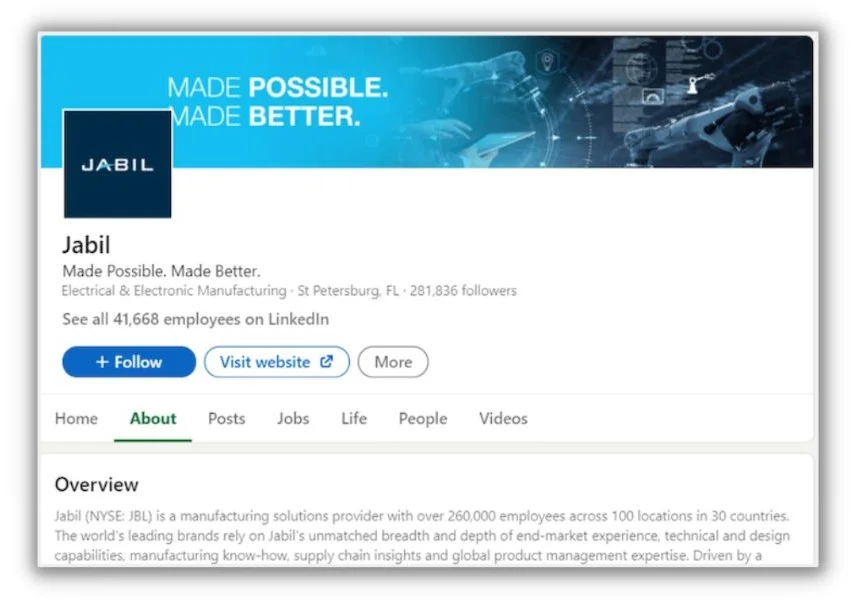

Each social network has different profile styles, but in general:
If you’re connecting through your personal LinkedIn account, gather some recommendations. In fact, it’s a good practice to trade LinkedIn recommendations with people you work with.
4. Personalize connection requests
After you’ve built a rapport by sharing content and conversing in the comments section, it’s time to formalize the relationship with a connection request. The best introduction messages are specific and relevant to the recipient. That’s true in social selling since you’ve done so much to create a personal connection.
Here are a few ways to personalize your connection requests:
- Mention people you’re both connected with
- Call back to a recent interaction you’ve had
- Provide something of additional value (like a link to a relevant article)
- Use their name and reference their company or job title
5. Continuously grow your network
Social selling isn’t a one-and-done strategy. It’s a long-term play that gains steam over time. Set weekly goals for the number of posts, comments, and replies you publish. Block out time dedicated only to tending to your social media network.
And most of all, don’t rush it. Many of your new connections won’t need what you sell right now. But they will eventually. And even if they don’t, they could offer a warm introduction to other people in the future.
6. Be active in comments and replies
This is a foundational tactic of social selling. A well-timed, relevant comment is your first foot in the door with a new prospect. You are adding to the conversation, and your engagement helps boost the post with the platform’s algorithm.
Don’t forget to listen out for people who’ve already bought, too.
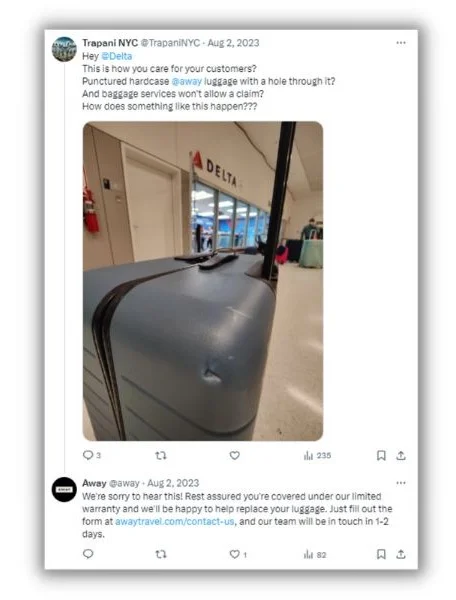

Jumping in to save the day is the ultimate social selling tactic.
7. Strike up conversations in your posts
You don’t always have to seek out people to converse with on social media. You can bring them to your posts with questions and polls.
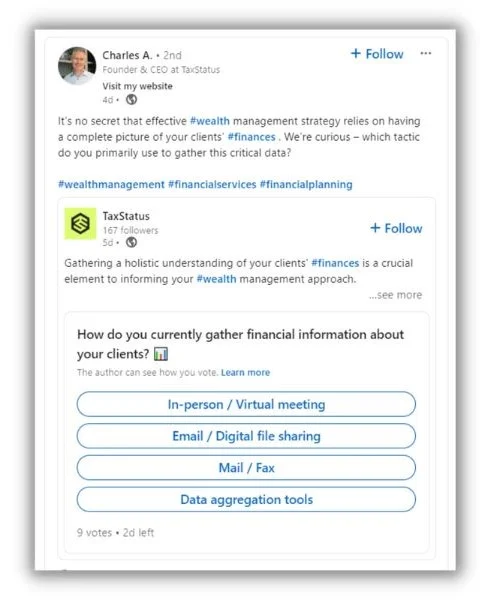

Whether they’re funny or serious, questions get people talking. Make a note of who shows up and what their opinions are. And always reply to keep the discussion going.
8. Engage with influencers
Influencers in your industry can be beneficial allies in your social selling campaign. They have an audience of people that you’d like to know. Plus, the topics they discuss could be great fodder for your posts and outreach.


You don’t need a formal agreement to engage with influencers. Just start liking and commenting on their posts. Reference and link to them in your own posts. Mine their comments sections to take the pulse of your industry and get new ideas. And invite them to collaborate on content.
9. Find communities to join
There are loads of online communities, both on social networks and elsewhere, just waiting for you to join. These groups are ideal for social selling since they’re all about conversing and providing mutual support.
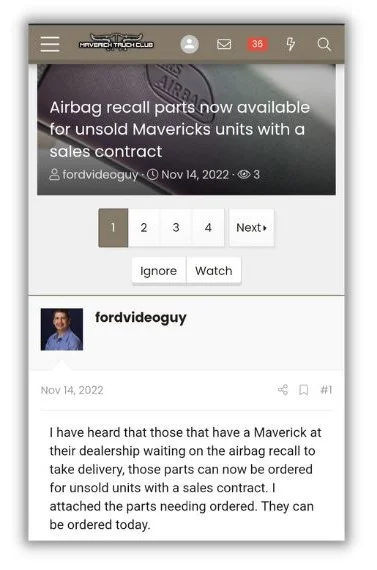

You can learn much about your target audience by observing what happens in an online group. But the real magic happens when you jump in, answer questions, and celebrate successes with the other members.
If you don’t see a group you like, build your own brand community.
What are the best social selling tools?
Social media management tools help you to become more efficient and effective at selling online. Here are a few such tools to consider.
LinkedIn Sales Navigator
It’s not surprising that LinkedIn would offer one of the best tools for social selling. What’s unexpected is just how robust LinkedIn Sales Navigator is.


One of the best features on Sales Navigator is the Relationship Explorer. With this tool, you’ll quickly find people who can help you get “in” with an organization—like people who share connections with you. It also helps you find the most relevant people to target and notifies you of important events like a change in management.
Meltwater
Meltwater is a leader in the social listening space for good reason. Its purpose-built tool lets you track brand, product, or audience mentions across all your social media accounts. You get audience sentiment data, and it can even recognize images.


The social listening alerts on Meltwater are worth noting. Set an alert for your brand, and you’ll get a notification when it’s mentioned. That’ll help you respond while the conversation is hot.
EveryoneSocial
EveryoneSocial is a brand advocacy platform that makes it easy for employees and executives to plan, post, and share content about their business. The tool has features designed to help sales professionals grow their pipeline on social media channels.
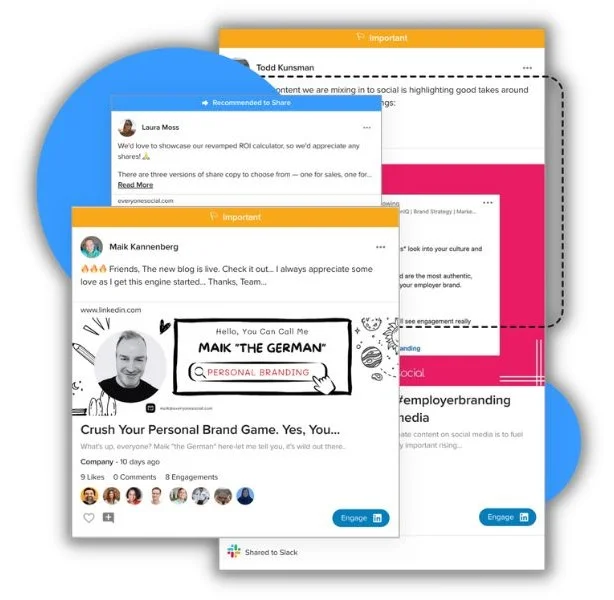

With EveryoneSocial, you get a hub of content anyone on your team can share through their social channels. You also get an analytics dashboard that shows the team’s engagement, reach, clicks, and more from all the accounts linked to your plan.
3 stellar social selling examples
Here are a few real-world examples of businesses big and small selling on social media with flair.
TruMotion Therapy
Here’s an example that proves social selling isn’t just for the Fortune 500. TruMotion Therapy is a local physical therapy practice that regularly posts on Instagram. They’ve built a loyal following of people looking for solutions to aches and pains.


The activity after the post is published transforms this strategy from social media marketing to social selling. TruMotion Docs take time to continue the conversation with individual commenters. Many of the replies are personalized advice and answers. And when it’s called for, the TruMotion team will take the chat to DMs, moving the new connection further down the funnel towards becoming a client.
Starbucks
You may not think of chain restaurants or consumer brands as social sellers, but some are really good at it.
Scroll through Starbucks’ feed on X, and you’ll see an endless stream of interactions the brand has with its fans. Most are simple “cheers,” while others are more personal.


Either way, social media lets Starbucks connect with a singular customer one-on-one in a way other marketing and advertising strategies don’t.
Zoetis CEO
Kristin Peck is the CEO of Zoetis, a pharmaceutical company specializing in pet care. She regularly comments on posts from people in her industry, especially when they mention animals.


It’s a quick and easy way to generate camaraderie among people in your network. Plus, you can use your comments to inspire future posts to help establish your brand on social media.
The 30-day social selling launch plan
Let’s bring all of this down to ground level. Follow this step-by-step plan for the next 30 days to have a fully functioning social selling strategy.
Day 1 to 5: Get set up
The first week is about picking the tools you’ll use, setting them up, and creating the rules for your social selling strategy. Some of this may already be done if you’re marketing on social media.
To get set up:
- Decide which social media platforms you’ll use
- Create a social media style guide
- Find relevant hashtags
- Create and optimize your social media profiles
- Pick your social selling tools
- Set up social listening for brand, competitor, and industry mentions
- Review five competitor social media accounts
Day 6 to 15: Establishing credibility
Now, it’s time to lay the groundwork with your audience. Go into this phase looking for ways to help and show off your expertise (without bragging, of course).
To establish credibility:
Day 15 to 25: Begin outreach
We’re getting more proactive here. Let’s find some people and social media accounts to lightly engage with.
To begin outreach:
- Search for people in your industry that post often
- Narrow the list to 10 targets
- Reply to 2 to 3 posts from each account
- Go beyond agreeing and add to the conversation
- Repost or retweet content from at least one of those posts and tag the account
Day 26 to 30: Make contact and analyze
For this last phase, you’ll connect directly with one new contact and check the results of your efforts so far.
To make contact and analyze:
- Send a connection request to one new contact
- Review the metrics on your social selling tool of choice
- Note which posts, comments, and replies get the most engagement
- Use the data to plan out month two
Now, keep growing your network!
👋 Plan out your entire year’s marketing strategy with this free must-have marketing calendar.
Social selling FAQs
Here are answers to some of the most commonly asked questions about social selling.
Does social selling really work?
The data proves social selling helps you fill your sales pipeline and close bigger deals more often.
For example:
- Instagram found that 78% of social sellers outperform peers who don’t use social media
- EveryoneSocial says a lead generated through social selling is 7x more likely to close than leads from other tactics.
- 51% of Baby Boomers, 69% of Gen X, and 86% of Gen Z have interacted with a company on social media.
What is social selling the inbound way?
An inbound marketing strategy attracts new buyers to you instead of chasing them through ads and cold outreach. Social selling is inbound by nature. So, “social selling the inbound way” is another way of saying social selling.
Is social selling creepy?
Social selling is not creepy if you do it the right way. That means engaging at appropriate times and offering help instead of leading with a sales pitch.
Grow your business with social selling
The days of knocking on doors and cold-calling prospects are numbered. Generic sales scripts turn buyers off. And impersonal outreach gets ignored in the inbox. Replacing these old-school sales techniques are genuine connections and authentic relationships built on social media.
It doesn’t take a considerable effort to give social selling a try. Just start reading posts that interest you and add your two cents. People will notice, and you’ll be off and running.
PPC
The Important Takeaways from Google I/O 2024

Google I/O 2024, the Silicon Valley giant’s annual developer conference, brought a bunch of exciting updates and advancements across various Google platforms and services. signalling a new era of intelligent, creative, and responsible technology.
Here’s an in-depth look at the key announcements and features unveiled during the event.
Google Search Gets Smarter
No surprises that one of the biggest stories to come out of Google I/O 2024 is about the enhancement of Google Search. AI Overviews are now being rolled out to all users in the U.S., providing deeper insights with just one search query. This feature leverages Google’s latest AI model, Gemini, allowing users to ask complex questions and receive comprehensive answers.
For example, users can now search for “best yoga or pilates studios in Boston” and not only receive a list of studios, but also specific details such as introductory offers and walking times from their location. This level of detail and integration aims to make search results more actionable and relevant, and improve user experience.
Enhanced Brainstorming Capabilities
Google Search is also becoming a tool for creativity and inspiration. The new brainstorming feature helps users find tailored suggestions for various needs. For example, if someone searches for “anniversary celebration dinner places Dallas,” they will elicit personalized recommendations, complete with categories to explore, such as types of cuisine, ambiance, and special offers.
This enhancement transforms Google Search into more than just an information retrieval tool—it becomes a creative assistant, helping users plan and make decisions with ease and confidence.
Interactive Video Search
Another ground-breaking update is the introduction of Interactive Video Search. This feature allows users to search within video content to find specific insights. Imagine watching a cooking video and being able to search for a particular step or ingredient explanation within the video. This capability deciphers complex video content, making it easier to locate and understand the information presented.
Interactive Video Search is expected to be a game-changer for educational content, tutorials, and entertainment, providing a more dynamic and user-friendly way to engage with video media.
Gemini Tools for Developers
Google is also empowering developers with new tools. The Gemini 1.5 Pro and Flash models are now available in over 200 countries, offering advanced capabilities and integrated collaboration features within Workspace apps like Gmail and Docs. These tools is to enhance productivity and innovation in the development community.
The integration within Workspace means developers can collaborate more effectively, leveraging AI to streamline coding, debugging, and deployment processes. The global rollout ensures developers everywhere have access to the latest technologies to build and improve their applications.
Generative Media Models
Content creation is set to become more intuitive with the introduction of generative media models. Google unveiled Imagen 3 and Veo, tools that allow users to create images and videos from text prompts. This technology is especially useful for marketing campaigns, social media content, and other visual storytelling demands.
With Imagen 3, users can generate high-quality images simply by describing them, while Veo enables the creation of compelling video content from text-based descriptions. These tools lower the barrier to professional-grade content creation, making it accessible to individuals and businesses alike.
Responsible AI Initiatives
Amid all these advancements, Google says it remains committed to the responsible deployment of AI. The introduction of SynthID is a significant step towards easier identification of AI-generated content. SynthID embeds a subtle but detectable watermark in AI-generated images, ensuring transparency and authenticity in digital media.
Additionally, LearnLM is another innovative tool aimed at promoting responsible AI use. It provides educational resources and best practices for developing and deploying AI models, helping developers understand the ethical implications and technical standards required for safe AI usage.
In Summary
Google I/O 2024 showcased a range of innovations that not only enhance user experience but also push the boundaries of what’s possible with technology. From smarter search capabilities and creative brainstorming tools to advanced developer resources and responsible AI practices, Google continues to lead the way in making technology more accessible, intuitive, and ethical.
These updates reflect Google’s ongoing commitment to leveraging AI for the betterment of society, ensuring that their technological advancements are both innovative and responsible. Users and developers alike can look forward to a more connected, efficient, and creative future with these new tools and features.
PPC
Ultimate Guide to Product Data Feed Management

From the early days of simple online catalogs to today’s dynamic, data-driven shopping experiences, the e-commerce landscape has seen a monumental shift, driven by advances in technology and changes in consumer behavior. This transformation has not only expanded the reach of retailers but also heightened the competition and complexity of selling online.
Overview of the E-commerce Landscape
The current e-commerce landscape is a vast, interconnected ecosystem. It is one where businesses of all sizes compete to capture the attention and loyalty of digital consumers.
Ecommerce spans various channels, including online marketplaces like Amazon and eBay. It involves social commerce platforms such as Instagram and Facebook. It is conducted by countless individual online stores powered by platforms like Shopify, BigCommerce, and WooCommerce.
Each of these channels offers unique opportunities and challenges. Each demands a particular approach to engaging with potential customers.
As the digital marketplace continues to grow, so does the importance of maintaining a strong online presence.
For businesses, this means more than just listing products online. It involves creating comprehensive, engaging, and personalized shopping experiences that resonate with consumers across multiple touchpoints.
The Evolution of Online Shopping and the Role of Data
The evolution of online shopping is a story of technological innovation and changing consumer expectations.
Initially, online shopping offered a convenient alternative to physical stores, allowing consumers to purchase products from the comfort of their homes.
Over time, the advent of mobile technology, social media, and advanced data analytics has transformed online shopping into an immersive and interactive experience.
Today, consumers can receive personalized product recommendations, see targeted ads, use augmented reality to “try on” products, and enjoy seamless omnichannel shopping experiences that blur the lines between online and in-store.
At the heart of this evolution is data.
Data fuels the algorithms that predict shopping behavior, tailor marketing messages, and optimize the online shopping experience.
Effective product data feed management plays a crucial role in this ecosystem. It involves not just listing products online but strategically managing and optimizing product information, ensuring it reaches the right audience, at the right time, in the right way.
This process is vital for improving product visibility, enhancing customer experiences, and ultimately driving sales in a crowded and competitive digital marketplace.
As we delve into the intricacies of product data feed management, it’s important to recognize its significance as the backbone of successful e-commerce strategies.
By understanding and leveraging the power of data, businesses can navigate the complexities of the digital marketplace and create meaningful connections with their customers.
What is Product Data Feed Management?
The ability to efficiently distribute, update, and optimize product information across multiple online channels is paramount. Product data feed management facilitates this critical function. It is a process that stands at the core of successful online retailing.
Definition and Explanation of Product Feeds
A product feed, fundamentally, is a structured file—often in formats like XML, CSV, or JSON—that contains detailed information about the products in an online store’s catalog.
This file serves as a digital product list, designed to be ingested by various e-commerce platforms, search engines, social media channels, and comparison shopping websites.
Product feeds include essential details such as product titles, descriptions, images, prices, stock levels, and more—each attribute meticulously organized to meet the specific requirements of different digital channels.
Product data feed management encompasses the creation, maintenance, and optimization of these product feeds.
It involves regular updates to ensure accuracy of product information, strategic modifications to enhance product visibility and appeal, and careful adherence to the data standards and specifications of each target platform.
The goal is to streamline the process of listing and advertising products across the web, ensuring that potential customers encounter consistent, accurate, and engaging product presentations, no matter where they find them.
Importance of Product Data in E-commerce
We cannot overstate the significance of product data in e-commerce. In an online marketplace where consumers rely heavily on product information to make purchasing decisions, the quality and presentation of this data directly impact sales performance.
High-quality product feeds enable:
- Improved Visibility: Optimized product data feeds help products to surface in search results and feature prominently in comparison shopping engines, directly influencing discoverability.
- Enhanced Customer Experience: Detailed, accurate product descriptions and high-quality images help build consumer trust and reduce the likelihood of returns. They provide the necessary information to aid consumers in making informed purchasing decisions, enhancing the overall shopping experience.
- Increased Conversion Rates: By ensuring product listings are optimized for relevance and appeal (including SEO-friendly product titles and descriptions, compelling images, and competitive pricing), merchants can significantly improve their chances of converting browsers into buyers.
- Streamlined Operations: Effective data feed management simplifies the process of listing products on multiple channels, reducing manual effort and minimizing the risk of errors. This efficiency is crucial for businesses scaling their online presence across various platforms.
In the context of today’s online shopping environment, where customer engagement and satisfaction are key drivers of success, the role of data feed management extends beyond mere product listings.
It is about crafting a narrative for each product that resonates with potential buyers, leveraging data to tell compelling stories that captivate and convert.
As such, product data feed management is a critical component of any e-commerce strategy, ensuring that products are not just seen but also chosen, liked, and purchased.
Why Product Data Feed Management is Important
In the digital marketplace, where competition is fierce and consumer attention is fleeting, the strategic management of product data feeds emerges as a crucial lever for e-commerce success.
Its importance is multifaceted, impacting everything from how products are discovered to how they’re evaluated by potential customers.
Impact on Visibility and Sales Across Channels
A well-managed product data feed is instrumental in amplifying a product’s visibility across various online channels.
Each e-commerce platform, marketplace, and comparison shopping engine has its own unique set of requirements for listing products. By meticulously optimizing product feeds to meet these specifications, businesses ensure that their products are not only listed but also positioned favorably within these channels.
This optimization can include keyword-rich product titles and descriptions, high-quality images, and competitive pricing information, all tailored to align with the search behaviors and preferences of the target audience.
The direct result of increased visibility is, quite naturally, an uplift in sales.
Products that are easy to find and presented compellingly are more likely to attract clicks and, subsequently, purchases.
Furthermore, optimized product feeds contribute to more effective and efficient advertising campaigns. By targeting the right consumers with the most relevant and appealing product information, businesses can significantly improve their return on investment (ROI) in marketing, driving both sales and profitability.
Role in Improving Customer Decision-Making and Satisfaction
Beyond the immediate benefits of visibility and sales, product data feed management plays a vital role in enriching the customer’s shopping experience.
In an online environment devoid of physical touchpoints, product information is the primary means through which consumers interact with and evaluate offerings.
Detailed and accurate product feeds help bridge the gap between online browsing and the tangible experience of shopping in a store. They provide customers with the information needed to make informed purchasing decisions, reducing uncertainty and the likelihood of dissatisfaction.
High-quality product data feeds also allow for the personalization of the shopping experience. By leveraging data insights, businesses can tailor product recommendations, ads, and promotions to match the specific interests and preferences of their audience.
This level of personalization enhances customer engagement and loyalty, as shoppers feel understood and valued by the brand. It also streamlines the shopping process, making it easier and more satisfying for customers to find products that meet their needs and desires.
Moreover, effective management of product data feeds ensures consistency across channels, further improving customer trust and confidence.
When product information, pricing, and availability are synchronized across all platforms, it creates a cohesive and reliable brand experience. This consistency is crucial for maintaining customer satisfaction and fostering long-term loyalty.
Optimized product feeds are a powerhouse for e-commerce marketing, offering substantial benefits for ad campaigns and search relevancy. These advantages are pivotal in navigating the competitive landscape of online retail, where the ability to capture consumer attention at the right moment can make the difference between a sale and a missed opportunity.
Benefits for Ad Campaigns
For advertising campaigns, particularly those running on platforms like Google Shopping, Facebook, and Instagram, the quality and optimization of the product feed directly influence the campaign’s effectiveness.
A well-optimized product feed ensures that ads are not only displayed but also resonate with the target audience. This optimization includes accurate and enticing product descriptions, high-quality images, and the right use of keywords and categories that align with what potential customers are searching for.
An optimized feed allows for more targeted and personalized ad campaigns.
By segmenting feeds based on product categories, price ranges, or even customer behaviors, businesses can create tailored ad experiences that speak directly to the interests of different audience segments.
This targeted approach increases the relevance of ads, improving click-through rates (CTR) and conversion rates, thereby maximizing the ROI of advertising budgets.
Furthermore, dynamic remarketing campaigns, which display products that a visitor has previously viewed or shown interest in, rely heavily on the precision and detail of product feeds to re-engage potential customers effectively.
Data feeds play a pivotal role in the integration and success of paid search campaigns on platforms like Google Ads and Microsoft Advertising.
Understanding how these feeds interact with paid search platforms can significantly enhance the effectiveness of your advertising efforts, leading to better targeting, higher conversion rates, and improved ROI.
Here’s an in-depth look at how data feeds work within the context of paid search platforms.
Fundamentals of Data Feeds in Paid Search
At the core of paid search advertising, especially for e-commerce, are product data feeds.
These feeds serve as the foundation for creating dynamic and highly targeted ads based on the product information stored in your e-commerce platform.
For platforms like Google Shopping and Microsoft Shopping Campaigns, your product feed is uploaded to their Merchant Center, where it’s used to generate Shopping ads that are displayed across search results and other Google or Microsoft properties.
Structure and Optimization
A product data feed for paid search is typically structured in a CSV, XML, or a Google Sheets format, containing detailed attributes of each product such as title, price, image URL, product ID, and stock status.
Optimizing these attributes is crucial for the success of your campaigns.
Effective titles and descriptions that incorporate relevant keywords can improve the visibility of your ads, while high-quality images enhance click-through rates.
Additionally, accurate pricing and availability information helps to reduce the bounce rate and increase consumer trust.
Dynamic Ad Creation
Paid search platforms utilize the information in your product feed to automatically create ads that are tailored to the search queries of potential customers.
This process involves matching the keywords and product categories in your feed with the terms users are searching for.
As a result, when someone searches for a product that matches an item in your feed, the platform can dynamically generate an ad that showcases the product, complete with its image, title, and price.
Targeting and Personalization
Data feeds enable sophisticated targeting and personalization options in paid search campaigns.
By analyzing the data in your feed, these platforms can serve ads to users based on their previous interactions with your website, search history, and purchasing behavior.
For instance, remarketing campaigns can target users who have viewed specific products on your site but did not make a purchase, showing them ads for those very products as they browse the web or use social media.
Performance Tracking and Optimization
Integrating your product feed with paid search platforms allows for detailed performance tracking at the product level.
You can see which products are generating clicks, impressions, and conversions, and adjust your feed and campaign settings accordingly.
This might involve pausing ads for underperforming products, increasing bids for high-value items, or optimizing product titles and descriptions for better performance.
Continuous Updates
To maintain the relevance and effectiveness of your paid search campaigns, it’s vital to keep your product feed updated.
Changes in product availability, pricing, or promotional offers need to be reflected in your feed in real-time or as close to it as possible.
Many platforms offer the option to schedule regular feed uploads or enable direct API connections for continuous updates, ensuring that your ads always display the most current information.
Enhancing Search Relevancy
For search engines and online marketplaces, the relevancy of product listings plays a crucial role in visibility.
Optimized product feeds contribute to higher search relevancy by ensuring that product information is comprehensive, accurate, and keyword-optimized.
This means that when consumers search for products, the chances of your listings appearing in their search results are significantly increased.
Moreover, detailed and well-structured product feeds help algorithms better understand and categorize your products, making it more likely for them to show up in relevant searches and for related products.
This alignment with consumer search intent not only boosts visibility but also drives more qualified traffic to your listings—consumers who are actively seeking what you’re offering.
Optimizing product feeds for search relevancy also involves updating feeds regularly to reflect changes in inventory, pricing, and product details. This consistency ensures that search engines and marketplaces have the most current information, further improving the accuracy of search results.
It reduces the likelihood of customer frustration caused by outdated information, such as discontinued products or incorrect prices, enhancing the overall shopping experience and fostering trust in your brand.
Who Needs to Conduct Product Data Feed Management?
While product data feed management is a universal necessity in e-commerce, the scale and approach can vary significantly based on several factors.
Differentiation by Business Size, Catalog Complexity, and Sales Channels
Small Businesses and Startups: Small businesses, especially those with a limited number of products, may initially manage their product feeds manually or with minimal automation.
However, even small operations can benefit from basic product data feed management practices to ensure their products are accurately listed across preferred sales channels.
As they grow, the complexity and time investment required to manage feeds manually can quickly become impractical.
Mid-sized Businesses: For mid-sized businesses with larger catalogs and sales across multiple channels, the complexity of managing product feeds escalates.
These businesses often deal with dynamic inventories, frequent promotions, and the need to optimize product listings for different platforms.
At this stage, the efficiency, accuracy, and scalability provided by a dedicated product feed management solution become increasingly critical.
Large Enterprises: Large enterprises with extensive product catalogs, global markets, and sales across numerous channels face significant challenges in maintaining consistency, accuracy, and optimization of product data feeds.
Advanced product feed management solutions, often customized and integrated with other enterprise systems, are essential to manage the scale and complexity of their operations effectively.
Indications Your Business Needs a Data Feed Management Solution
Expanding Product Catalog: As your product range grows, so does the complexity of managing each product’s data. A solution that can automate updates and optimize listings becomes invaluable.
Increasing Sales Channels: Selling across multiple platforms (e.g., your website, Amazon, eBay, Google Shopping) introduces specific requirements and complexities for each channel. Managing feeds for each platform manually can become overwhelming.
Time and Resource Constraints: If updating product listings is consuming a disproportionate amount of time or if errors are becoming more frequent due to manual updates, it’s time to consider a more streamlined approach.
Marketing and Sales Challenges: If you’re finding it difficult to effectively target or retarget potential customers through ad campaigns due to poor data quality or if you’re unable to leverage dynamic pricing and promotions effectively, a product data feed management solution can offer significant advantages.
International Expansion: Selling in multiple countries requires tailoring product information to different languages, currencies, and cultural nuances. Managing these variations without a robust feed management system can limit your ability to scale globally.
Inventory Management Issues: Difficulty in synchronizing inventory levels across different channels, leading to overselling or stock discrepancies, indicates a need for better feed management.
How to Do Product Data Feed Management
Effective product data feed management is a multifaceted process, requiring attention to detail, strategic planning, and the right tools. Here’s a comprehensive approach to managing your product data feeds efficiently and effectively.
1. Assess Your Current Data Feed Status
- Audit Your Product Data: Begin by evaluating the quality and completeness of your current product data. Identify gaps, inaccuracies, or areas lacking optimization, such as missing product descriptions, poor-quality images, or inadequate use of keywords.
- Understand Channel Requirements: Each sales channel has its own set of requirements for product feeds. Familiarize yourself with these specifications to ensure your product data aligns with each channel’s format, data fields, and quality standards.
2. Optimize Your Product Data
- Enhance Product Titles and Descriptions: Make them descriptive and keyword-rich to improve search visibility and relevancy. Tailor content to match the search behavior of your target audience.
- Improve Image Quality: Use high-resolution images and ensure they accurately represent the product. Consider multiple angles and use cases to provide a comprehensive visual overview.
- Standardize and Enrich Data: Ensure consistent use of categories, types, and attributes across your product range. Add any missing information that could enhance the listing, such as dimensions, materials, or special features
- Map Your Product Attributes to Channel Specifications: Create a mapping document that aligns your product attributes with the requirements of each sales channel. This ensures that critical product information is translated correctly and efficiently into each channel’s specific format, minimizing the risk of errors and omissions.
- Utilize High-Quality Data Sources: Ensure your product information is being pulled from high-quality, reliable sources within your organization. This might involve integrating with your ERP or inventory management system to access the most up-to-date and accurate product data.
- Implement Rich Media: Beyond standard images, consider incorporating videos, 360-degree views, and other rich media into your product feeds. This can significantly improve engagement and conversion rates by providing a more immersive product experience.
- Optimize for Mobile: Given the increasing prevalence of mobile shopping, ensure your product feeds are optimized for mobile platforms. This includes mobile-friendly images, concise and impactful product titles, and descriptions that are easy to read on smaller screens.
- Adopt Schema Markup: Utilize schema markup for your online store’s pages to help search engines better understand and display your product information in search results, potentially increasing visibility and click-through rates.
- Ensure Cross-Channel Consistency: Regularly review your product feeds across all channels to ensure information is consistent and up-to-date. Discrepancies in pricing, availability, or product details can erode customer trust and hurt your brand’s reputation.
- Regularly Refresh Promotional Content: Update your product feeds to reflect current promotions, seasonal offers, or limited-time discounts. This keeps your listings fresh and encourages repeat visits and purchases.
- Implement Dynamic Pricing: Where possible, use dynamic pricing strategies within your product feeds to remain competitive. Adjust prices based on market demand, competitor pricing, and inventory levels to optimize sales and margins.
3. Select the Right Product Feed Management Tool
- Evaluate Features and Compatibility: Choose a tool that not only offers feed creation and optimization features but also integrates seamlessly with your e-commerce platform and preferred sales channels.
- Consider Scalability: The tool should be able to grow with your business, handling an increasing number of products and complexity without performance issues.
- Look for Automation Capabilities: To save time and reduce errors, opt for a solution that automates routine tasks like feed updates and inventory management.
4. Implement Feed Management Best Practices
- Regularly Update Your Feeds: Ensure your product feeds are refreshed frequently to reflect inventory changes, price updates, and any modifications to product details.
- Monitor Feed Performance: Use analytics to track how your products are performing across different channels. Identify trends, such as top-performing products or channels, and adjust your strategy accordingly.
- Test and Optimize: Continuously experiment with different aspects of your product data (e.g., titles, descriptions, images) to see what resonates best with your audience and leads to higher conversion rates.
- Conduct Competitive Analysis: Regularly review your competitors’ product listings on key channels to identify trends and strategies that may be effective. This could include promotional tactics, use of specific keywords, or presentation styles. Understanding what works for competitors can offer valuable insights to refine your own product feed strategy.
- Engage in Continuous Learning: Stay informed about the latest trends and best practices in e-commerce and product data management. Participating in webinars, following industry blogs, and joining professional groups can provide ongoing education and insights into how to manage your product feeds more effectively.
5. Stay Compliant and Up-to-Date
- Keep Abreast of Channel Updates: Sales channels often update their feed requirements and algorithms. Stay informed about these changes to ensure your feeds remain compliant and optimized.
- Adapt to Market Trends: Be responsive to shifts in consumer behavior and market trends. Update your product data to highlight relevant features or benefits that meet evolving customer needs.
Product Data Feed Management Tools and Services.
There are many companies who offer some form software that aids the potentially laborious process of product data management. Some only work for certain marketplaces, others are limited to certain ecommerce platforms like shopify or woocommerce.
Amongst them you should be able to find a suitable partner to manage your product data feed though.
Feedonomics (https://feedonomics.com/) offers a leading full-service data feed management platform that optimizes and syndicates product data across a wide range of digital marketing channels and marketplaces.
Their service emphasizes improving feed quality for better ad performance and e-commerce success.
Adsmurai (https://www.adsmurai.com/) provides advanced marketing technology solutions with a focus on optimizing social media advertising campaigns.
They offer tools for creative management, campaign automation, and performance analysis across platforms like Facebook, Instagram, and Pinterest.
FeedSpark (https://www.feedspark.com/) specializes in data feed optimization and management, helping businesses improve their online presence and sales through better product visibility across shopping channels and search engines.
ShoppingIQ (https://www.shoppingiq.com/) offers a technology platform geared towards optimizing e-commerce operations, particularly in managing and optimizing product feeds for shopping comparison engines and marketplaces to enhance ROI.
DataFeedWatch (https://www.datafeedwatch.com/) is a comprehensive data feed management tool designed to help merchants and agencies optimize and customize their product feeds for over 1000 shopping channels and marketplaces to improve campaign performance.
WakeupData (https://www.wakeupdata.com/) provides a powerful feed management platform that allows e-commerce businesses to transform, optimize, and automate their product data feeds to increase sales and performance across multiple marketing channels.
Channable (https://www.channable.com/) offers an e-commerce tool for feed management, PPC automation, and order synchronization, helping online retailers and marketers streamline their sales and advertising operations across various platforms.
Feedoptimise (https://www.feedoptimise.com/) provides services for managing and optimizing product feeds for e-commerce businesses, focusing on maximizing product visibility and performance across shopping channels and marketplaces.
SellerApp (https://www.sellerapp.com/) specializes in e-commerce analytics and intelligence, offering tools and services that help sellers optimize their presence and sales on platforms like Amazon with data-driven insights and strategies.
Scale Insights (https://scaleinsights.com/) is platform focused around Amazon PPC which helps their customers scale and automate their advertising campaigns on the mega successful ecomerce marketplace.
Arthy (https://www.getarthy.com/) is another Amazon focused tool. It’s broader than just feeds offering functionality around managing reviews, inventory etc.
Adverso (https://adverso.io/) is a platform to manage, optimize and track your Amazon campaigns smoothly with a solution designed for Amazon teams & agencies
ExportFeed (https://www.exportfeed.com/) specializes in creating and managing product feeds for e-commerce businesses, ensuring their products are listed across multiple shopping channels and marketplaces efficiently.
Lengow (https://www.lengow.com/) provides an e-commerce automation platform that helps merchants optimize their product listings and manage their sales across various online channels, including marketplaces, comparison shopping engines, and affiliate platforms.
Rithum (https://www.rithum.com/) came about from the combination of CommerceHub and ChannelAdvisor and claim to be a company providing end-to-end platform and network capabilities that create more durable, sustainable, e-commerce businesses to the leading brands, retailers, and suppliers of the world.
Baselinker (https://baselinker.com/) offers an integrated e-commerce platform that connects online stores with marketplaces, couriers, and sales support tools, automating sales processes and order management to increase efficiency.
Versafeed (https://www.versafeed.com/) provides a managed service for optimizing and managing product data feeds, focusing on enhancing product visibility and performance on search engines and shopping channels.
GoDataFeed (https://www.godatafeed.com/) offers a cloud-based feed management platform designed to simplify and automate the process of syndicating product data across a multitude of shopping channels, improving reach and efficiency.
AdNabu (https://www.adnabu.com/) specializes in Google Ads automation, offering software solutions that help e-commerce businesses optimize their Google Shopping campaigns for better performance and higher returns.
Relayter (https://www.relayter.com/) Simplify your marketing production for promotions and products. Automate creative work and streamline content workflows.
Adcore (https://www.adcore.com/technologies/feeditor/) provides a suite of marketing automation tools designed to help advertisers streamline their digital advertising efforts, with a focus on simplifying campaign management and optimization. Feeditor is there feed management tool.
Productsup (https://www.productsup.com/) offers a leading cloud-based platform for product content integration, syndication, and feed management, empowering businesses to manage and optimize their product data across various e-commerce channels.
PPC
Advanced Google Ads Techniques To Master In 2024
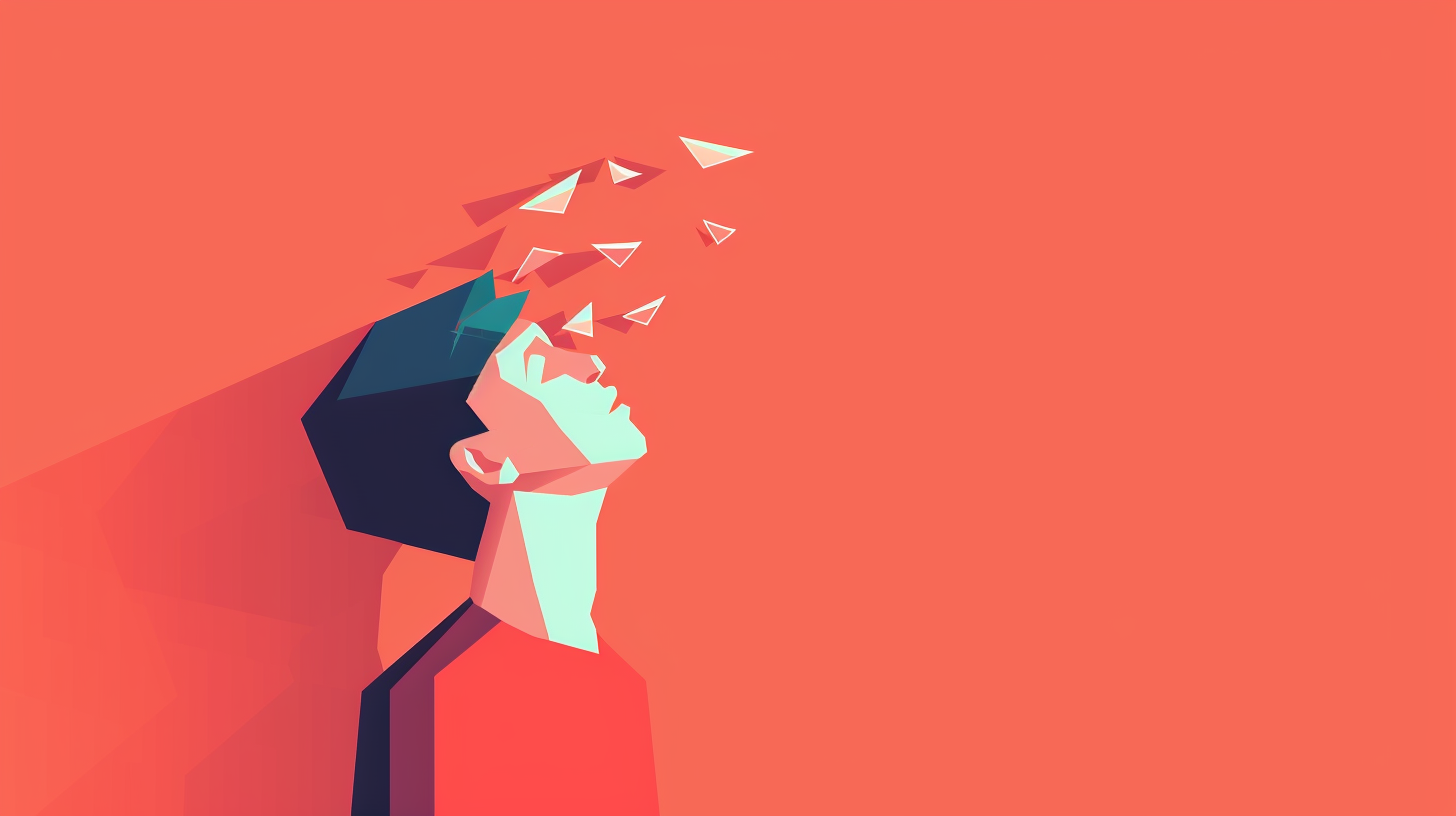
We’re nearly halfway through 2024, and already we PPC heroes have experienced a plethora of changes to get our heads around. How can we cut through the noise and focus on the specific tactics that will make an impact for the better?
Today we’ll take a look at a few advanced Google Ads techniques tips and tricks to master in 2024 – everything from making account management easier to tailoring your messaging at scale, and making your campaigns as effective and efficient as possible.
1. Auto-apply (some) recommendations
Fighting those pesky ‘optimization score’ reminders can be time-consuming – especially when they’re not always applicable. With targets to hit and maintain for Google’s partnership and support, it’s important to keep our optimization scores high at 80% or above.
Google’s optimization recommendations are split into the following categories:
- Ads and assets
- Automated campaigns
- Bidding and budgets
- Keywords and targeting
- Repairs
- Measurement
Each of these will have a unique score that will affect your overall optimization total for each of your accounts. Repairs are usually critical fixes, while minor keyword tweaks may come further down the priority list. (You can dismiss recommendations if they’re irrelevant, but I recommend reading the details behind each of them before rejecting them.)
To save time on manual campaign management, you can ask Google to auto-apply some of these tweaks for you – with a thorough ‘auto-applied recommendations’ history as well as optional email alerts.
I recommend adding these four as must-have auto-optimizations:
- Removing redundant keywords (keywords that have a close match within the same ad group and bidding strategy that performs better)
- Removing non-serving keywords (keywords with no impressions over a set period)*
- Updating keywords bids to meet ‘top of page’ bids etc. (You can still set an upper limit on this)
- Use optimized ad rotation (to show the best-performing ads more often instead of all ads within the same ad group equally, despite performance)
*As of June 2024, Google will automatically pause low-activity keywords: “Positive keywords in search ads campaigns are considered low-activity if they were created over 13 months ago and have zero impressions over the past 13 months.”
To opt-in to certain auto-applied recommendations:
- In your Google Ads account, click the Campaigns icon
- Click Recommendations.
At the upper right-hand corner, click Auto-apply, and select which recommendations to auto-apply.
2. Drive personalization through audiences
One way to drive personalization via search ads is by leveraging Google’s audiences. While marketers of yesteryear used to rely on keywords and geotargeting, today Google has a multitude of interested audiences to exploit across search, performance max, display, video, and demand gen campaigns. Don’t forget, audiences can be applied with both the observation setting and the targeting setting. Consider adding audiences to the observation setting first, adjusting to targeting once you have sufficient data.
By applying the following audience types to your campaigns and ad groups, you can double down on efforts to reach your target audiences through search.
Custom audiences
Create your own custom audience based on signals such as interests, behaviors, website viewing history (by URL), and app history. Think competitor brands or products, industry-related websites and apps, and recent relevant Google searches.
You could use custom audiences to personalize your ad copy on campaigns where you’re targeting customers of your competitors. For example, by encouraging them to ‘switch’ to your brand, product, or service, rather than treating them like a first-time purchaser. You could focus on the benefits of your product or service over the one they currently have, rather than focusing your ad copy on educating the audience from scratch.
In-market audiences
In-market audiences are a must-have in 2024. Curated by Google, these audiences actively research a specific product or service and are actively considering their options ahead of purchasing.
While there isn’t a master list of in-market audiences (because many of these are hidden!), head to the Audiences tab on your current Google Ads campaigns. Click “Edit Audience Segments”, then the Browse tab, and navigate to In-Market Audiences. You can look at all available groupings by industry, and add the most relevant ones to your campaigns. You can also use this function to type in keywords under the Search tab, and type in relevant keywords to find relevant in-market audience suggestions to apply.
Knowing these audiences are already convinced of the benefits of the general product or service you’re advertising, you can use your ad copy to highlight the USPs of your brand.
RLSAs
While the use of RLSAs (remarketing lists for search ads) has dropped since their arrival in 2013, they still have a place in an effective PPC strategy in 2024. By creating an RLSA, you can personalize your ad copy at scale.
The use of RLSAs is particularly applicable for brands with lengthier sales cycles, or longer customer consideration and comparison stages. Your brand could be 1 of 5 that a consumer is considering buying a hot tub from – it’s uncommon that a hot tub is an impulse purchase decision. A user may use Google to search multiple times for generic hot tub terms, and may whittle this down to certain brands based on their needs. Once a user who is actively looking for a hot tub has visited your website without converting, upon their next Google search, your ad may contain a coupon code, a complimentary gift item, or other differentiating ad copy to encourage them to purchase through your website.
It’s important with RLSAs to ensure that you have separate ad groups or campaigns. Also to separate RLSA audiences from other custom, in-market or demographic-based audiences.
Remember to test all new audiences by adding them as ‘observation’ audiences, before switching to the ‘targeting’ setting.
3. Harness your data
One of the more critical elements of a top-performing PPC campaign is data. You can have the best keywords, ad copy, and landing page in the world, but you need the right data to meet your goals.
A big data piece for 2024 is the perfection of conversion tracking, conversion events, and key events. With enhanced conversions also forcing their way to the fore, Google is no longer letting a lack of data confuse the attribution story.
At one time it was best practice to aim for a single conversion goal across all campaigns. In 2024, it’s important to measure a mixture of lighter conversion events too. For example, measuring PDF downloads and highly engaged video views on the path to a lead form submission. Or tracking customers who have abandoned their carts. Not only do these signals give you a clearer picture of the path to conversion, but these lighter goals can better guide Google’s machine learning and automated bidding strategy efforts.
Not only is conversion tracking crucial to success, but your conversion settings are key. Review the conversions list on your Google Ads account and check each goal for whether it’s a primary or secondary, or account default conversion setting. Having multiple account-default primary conversion goals will make it harder for Google to auto-optimize conversion-based bidding strategies. Choose one or two must-haves to keep as your primary conversion goal, and set the rest to secondary conversion goals.
4. Stop working on your Google Ads in isolation
One of the most valuable traits of a top-performing PPC manager is their knowledge of where PPC fits within the marketing funnel and wider marketing mix. Traditionally, PPC tactics have been assigned a bottom-of-funnel or lower-funnel position in the marketing mix.
In 2024, we need to adapt our thinking. Google Ads is no longer a BOF-only strategy. In fact, Google Ads can generate upper-funnel, mid-funnel, and lower-funnel results with the right strategy, campaign type, and goal tracking in place.
Not only that but Google Ads can support a multitude of cross-channel activities. You can use Google Ads to:
- Drive brand awareness and consideration on YouTube and other video partner platforms
- Capture brand demand generated from activity on social platforms such as Meta, TikTok, or Snapchat
- Similarly, capture brand demand generated from offline or traditional channels such as TV advertising, billboards, or print media
- Remarket to website traffic (from all sources) to generate conversions
- Boost brand loyalty, cross-sell, and up-sell opportunities using current customer data
This is another reason why data-driven attribution is a must-have in 2024. Today, Google Ads can influence multiple customer touchpoints. Last-click attribution is no longer an effective, representative, or scientific way of measuring the success of Google Ads activity.
5. Perfect your exclusions
For peak efficiency, exclusions are a must-have throughout your account. Particularly with the increased push for automated campaigns and campaign management that we’re experiencing.
It doesn’t matter if you’re only running search or performance max activity. Exclusions are almost always a part of an efficient campaign structure. The exclusions on your account might include negative keywords, specific audience exclusions (such as remarketing and already-converted audiences), brand exclusions, geotargeting exclusions, or placement exclusions.
Common negative keywords to consider may include:
- Free
- Jobs
- Download
- Cheap
- How to
- YouTube
- Amazon
- Sample
- Guide
- Logo
- Resource
- DIY
Without exclusions, you may find your ads are appearing to the wrong audiences, next to questionable or harmful content, or even that your ads are being triggered by irrelevant search terms entirely.
Summary
In 2024, there is a lot of noise in PPC advertising. By getting to grips with the above fundamentals of a healthy Google Ads account – targeting, personalization, data, simpler campaign management techniques, and adding relevant exclusions – you’ll be able to successfully navigate the complexities of managing your accounts at an advanced level.
-
SEARCHENGINES7 days ago
Daily Search Forum Recap: August 22, 2024
-
SEARCHENGINES6 days ago
Daily Search Forum Recap: August 23, 2024
-

 SEO7 days ago
SEO7 days agoData Confirms Disruptive Potential Of SearchGPT
-
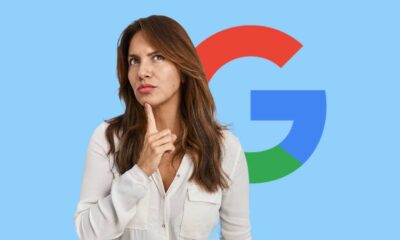
 SEO5 days ago
SEO5 days agoGoogle Cautions On Improper 404 Handling
-
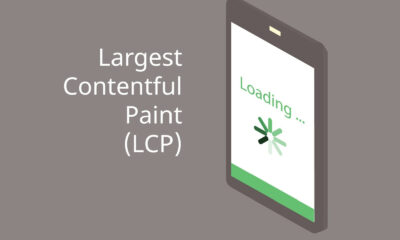
 SEO6 days ago
SEO6 days agoWhat Is Largest Contentful Paint: An Easy Explanation
-

 SEO4 days ago
SEO4 days agoGoogle’s Revamped Documentation Shows 4 Reasons To Refresh Content
-

 SEARCHENGINES4 days ago
SEARCHENGINES4 days agoGoogle Ranking Bug Fixed, August Core Update Swings, AI Overviews, Google Ads Bug & More
-
SEARCHENGINES2 days ago
Daily Search Forum Recap: August 26, 2024

